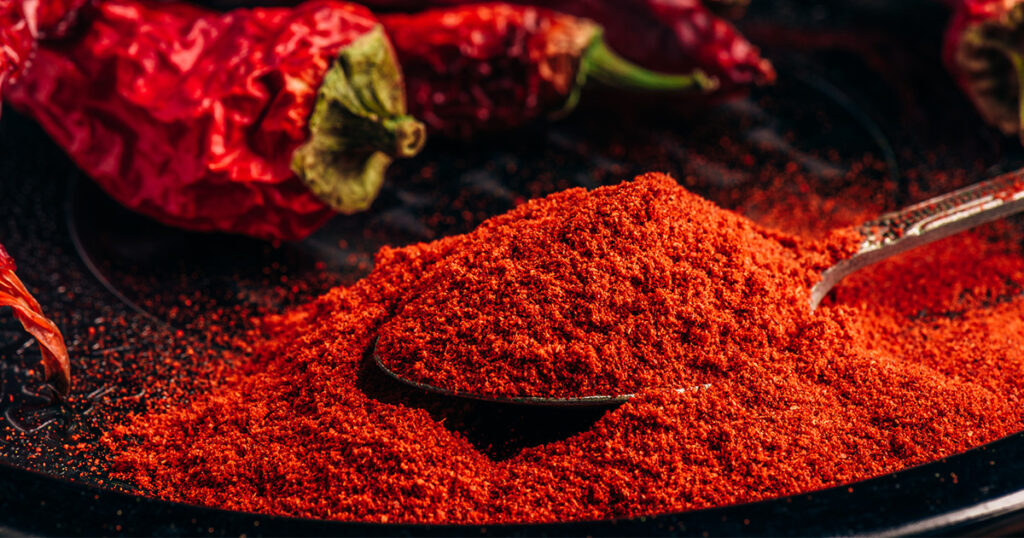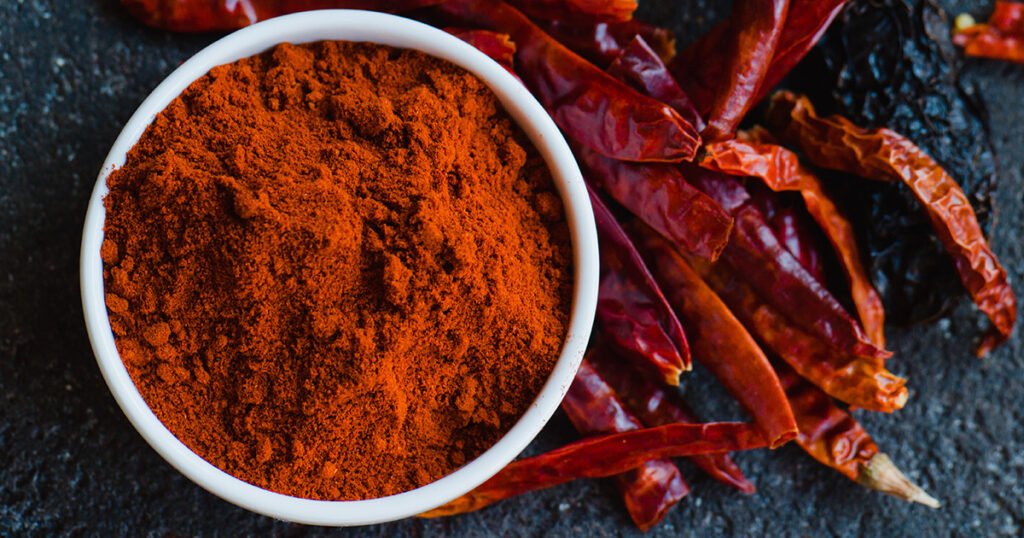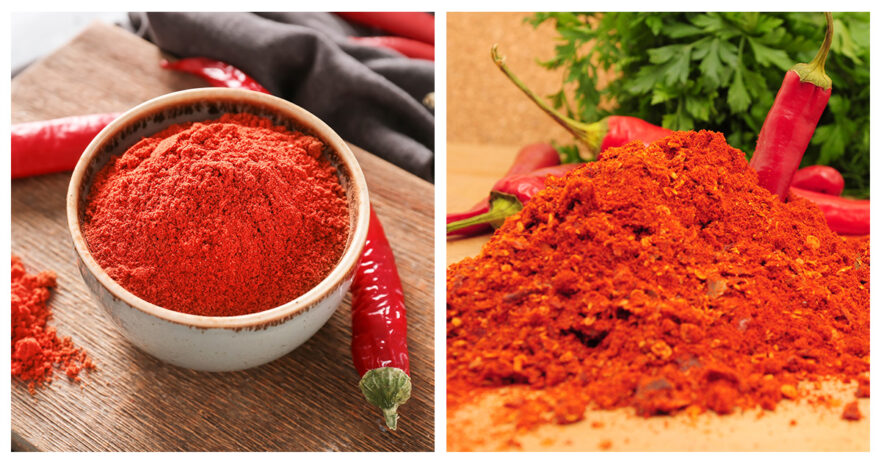The world of spices is intricate and colorful, each offering a distinct personality. Chili powder and cayenne pepper are two such spices that are frequently highlighted. Both seem to share a fiery red presence, but what truly sets them apart? In this comprehensive comparison, we’ll dissect the origins, flavors, culinary applications, and health benefits of these two vibrant spices, allowing you to choose the best one for your dish.
Table of contents
What is Chili Powder?

Chili powder, whether spelled as chile, chilli, or powdered chili, is a rich, flavorful blend derived from the dried and pulverized fruits of various chili pepper varieties.
Chili powder, far from being a single entity, can vary in heat and flavor depending on the type of chili pepper used. This includes a wide range of chilies, from milder chipotle and ancho varieties to the more intense Aleppo and chile de árbol varieties.
Some varieties are even closely associated with specific cuisines; for example, Gochugaru is a staple in Korean dishes and is made from sun-dried Korean red chili peppers, whereas Kashmiri chili powder, known for its vibrant red color but milder heat, is popular in Indian dishes.
However, chili powder is more than just chili peppers. Blends frequently include additional spices such as cumin, onion, garlic powder, and salt. The primary chili component is usually red chili peppers, but spicier blends may include hotter peppers to increase the heat level.
The spiciness of a chili powder can vary significantly due to the plethora of recipes and varying chili pepper combinations.
The origins of chili powder in the culinary world are inextricably linked to American history. While chili peppers originated in Central and South America, the commercial chili powder blend we know today is an American culinary innovation.
D.C. Pendery and William Gebhardt, among others, revolutionized commercial production. Gebhardt, in particular, transformed the culinary scene in New Braunfels, Texas, by popularizing chili as the town’s signature dish.
Faced with a seasonal scarcity of chili peppers, he cleverly imported ancho peppers from Mexico, ground them meticulously, and introduced the first commercial chili powder in the 1890s. This breakthrough cemented chili powder’s place in dishes like the beloved chili con carne and firmly established it at the heart of American culinary traditions.
What is Cayenne Pepper?

Cayenne powder is more than just a kitchen staple because of its intense heat and deep red color. It is an unapologetically fiery pure ground form of cayenne chili. Its heat is intense, with a Scoville rating of 30,000 to 50,000. It originated in the Cayenne region of French Guiana and has since spread across continents, finding its way into several culinary traditions.
Cayenne pepper’s fiery flavor has crossed over into a variety of cuisines. Cayenne pepper is a key ingredient in spicy Cajun dishes in the southern United States, which contributes to harissa’s heat. While it is not the primary chili in Latin American and Asian dishes, its adaptability allows it to find its way into many recipes, complementing the region’s rich tapestry of flavors.
Cayenne pepper is popular among both health enthusiasts and culinary masters. Its capsaicin-rich profile promises metabolism-boosting effects and flavor intensity that is difficult to match. The cultural ties are strong. The Korean Kimchi-making tradition, known as “Kimjang,” attests to this. Families gather here to blend and ferment ingredients, with cayenne pepper taking center stage.
Similarly, dishes bursting with cayenne pepper herald the triumph of vibrancy and warmth over dullness and coldness during Indian festivals. Cayenne pepper truly represents spice and the zest of life in a variety of landscapes and traditions.
While its culinary and medicinal properties are well known, the ecological significance of cayenne pepper is unknown. Its bright red color attracts birds, who enjoy the chili without feeling the burn because they are capsaicin insensitive. This bird-chili interaction promotes cayenne pepper seed dispersal, ensuring its spread across regions. Nature ensures the survival and spread of this fiery chili because humans have cultivated and spread the spice for its taste.
What are the similarities between Chili Powder and Cayenne?
Chili powder and cayenne pepper may appear as simple red spices derived from peppers at first glance. Nonetheless, a closer examination reveals common characteristics that make them indispensable to spice connoisseurs. They both add warmth and depth to dishes, infusing them with that desired kick and have become kitchen staples for many chefs worldwide.
Chili powder and cayenne pepper are both high in antioxidants. It is high in vitamin A, which is important for vision and immunity. Their carotenoid content further improves their nutritional profile, providing protective effects for eye health and possibly preventing certain age-related diseases.
The widespread use of chili powder and cayenne pepper in global cuisines attests to their adaptability. These spices leave an indelible mark on everything from aromatic curries in India to hearty dishes in Latin America. It’s not just about flavor; their heat can help digestion and metabolism.
Furthermore, chili powder and cayenne pepper are more than just ingredients; they are part of a tradition. Both spices are essential components of cultural events and festivals. Their heat represents vitality, energy, and passion, bringing communities together. Whether it’s the importance of chili in religious ceremonies or its use in traditional remedies, these spices transcend their culinary boundaries, woven into the very fabric of societies.
What are the differences between Chili Powder and Cayenne?
Despite their similarities, chili powder and cayenne pepper differ in many ways. The complex chili powder blend tempers the heat, offering flavors ranging from earthy to mildly spicy. On the other hand, cayenne provides a direct and unapologetic fiery punch in its purest form.
Chili powder has a wide range of culinary applications. It’s the foundation of many Tex-Mex dishes, BBQ rubs, and even some Asian dishes. Cayenne pepper, best known for its scorching heat, has emerged as the go-to spice for dishes that require a clear spicy note.
The two spices are also visually distinct; chili powder often has a darker hue, owing to its diverse ingredients, whereas cayenne stands out with its bright, fiery red color.
Chili powder, particularly the kind popular in the United States, can be traced back to American culinary innovation. Its roots are undeniably rooted in Southwestern and Texan cuisine. In contrast, the history of the cayenne pepper is extensive, stretching from the Cayenne region of French Guiana to its use in various global recipes.
Finally, the nutritional aspects differ slightly. While both spices provide vitamin A and carotenoids, chili powder may contain varying nutrient levels depending on the composition due to its mixture of ingredients. Cayenne pepper, being unique, provides consistent health benefits, primarily centered on its capsaicin content, which has been linked to metabolic benefits and pain relief.
FAQ about Chili powder and Cayenne pepper
Is cayenne spicier than chili powder?
In most cases, yes. Cayenne pepper has a Scoville rating ranging from 30,000 to 50,000, indicating a high heat level. Because chili powder is a blend, the heat level varies depending on the ingredients, but it is usually milder than cayenne.
What are their health benefits?
Both chili powder and cayenne are rich in vitamins and antioxidants. Cayenne’s capsaicin content has various benefits, including metabolism boosting and pain relief. Chili powder, with its blend, offers a broader range of nutritional benefits.
Can I substitute one for the other?
While both are derived from peppers, their distinct flavors mean that direct substitution can alter the flavor profile of a dish. Because cayenne pepper has a strong heat, adjust the amount and always taste-test.
How should I store them?
Both spices should be kept in airtight containers and cool, dark locations. Proper storage ensures maintained potency and preserves their rich flavors.
Which cuisines predominantly use chili powder and cayenne?
Chili powder is essential in Tex-Mex cooking, flavoring dishes such as chili con carne, enchiladas, and fajitas. It's also found in Southwestern American cuisine and some Indian spice blends. Cayenne pepper, on the other hand, has a broader culinary application. It's a popular ingredient in Indian curries, African harissa, and Thai soups. Because of their adaptability, both spices have found their way into numerous global recipes.

